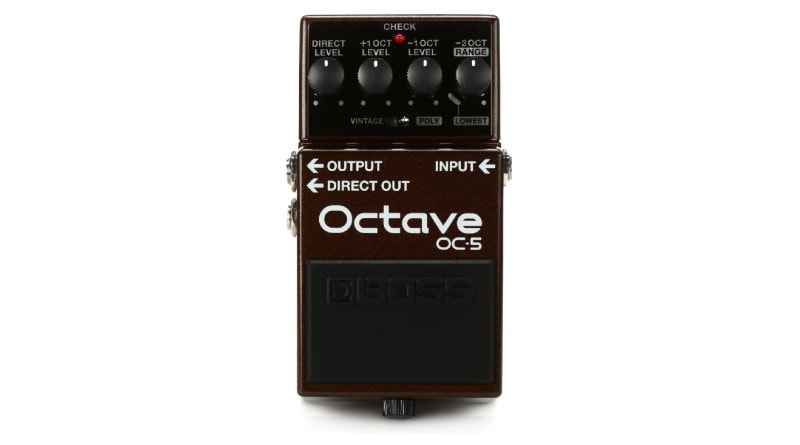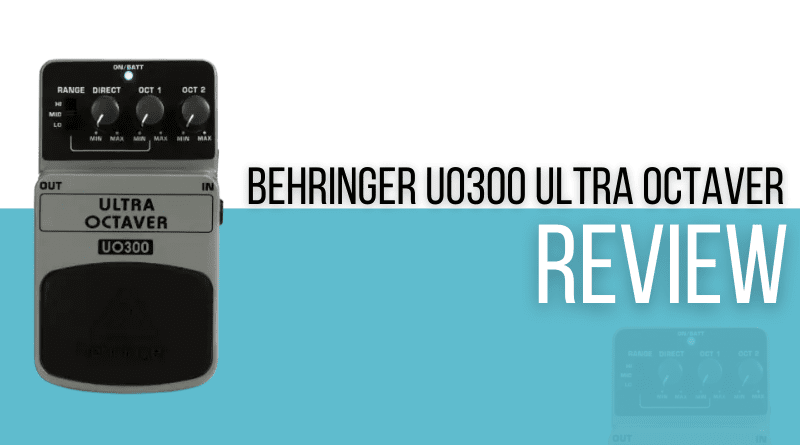Guitarists who are looking to build their first pedal board or even those trying to add to an ever growing collection of FX have, until now, had very few choices when it comes to gear that is both affordable and reliable. Many of the clones and copies on Amazon are made in limited runs, with little or no support from the retailer should anything go wrong. Enter Behringer…
If you can think of a big name pedal, Behringer has an equivalent that doesn’t just look the part, but sounds as good, and in some cases better, than the model that it emulates.
In this KillerGuitarRigs review, we’ll be looking at their UO300 Ultra Octaver, a pedal inspired by the industry standard (and now discontinued) Boss Super Octave OC-3. For players looking to get OC-3 tones without paying inflated prices for used gear, does the Behringer UO300 offer a viable alternative? Keep reading to find out more.
Read more about our review process.
Contents
Behringer UO300 Ultra Octaver: Who Is This Pedal For?
The Behringer UO300 is a great choice for guitarists of all ability levels, no matter whether they are just starting out, or they’ve been playing for years. It comes in at such a low price point that no matter your budget it’s an affordable option.
Octaver pedals such as the Behringer UO300 are perfect for anybody looking to get a fatter tone. These pedals work by taking the input signal and duplicating it with an additional output either an octave, or two octaves below, alongside the original signal. This can give the effect of having a bass guitar, without actually having a bass, or it can simply be used to achieve a fuller tone.
Behringer UO300 Ultra Octaver: Appearance / Features / Controls
If you’re familiar with the Boss OC-3, the you’ll find that the layout of the Behringer UO300 is very similar. The biggest exterior difference being the use of plastic in the housing, rather than metal as you’d find on a Boss, or other equivalent brand of premium pedal.
The Ultra Octaver is finished in a sleek dark grey color. Despite that fact that plastic housing isn’t ideal, we though that it looked great, and the construction is still sturdy enough to handle everything from bedroom practice to live gigs (as long as you’re not too hard on your gear).
There are three rotary dials on this pedal with a 3 position sliding switch. The first dial is ‘Direct’ – this knob controls the level, or volume, of the dry sound, allowing you to blend the original signal with the doubled signals. The ‘Oct 1’ knob controls the volume for the 1 octave down signal, and the ‘Oct 2’ dial controls the volume of the 2 octave down signal. The range selector switch is there to let you pick the most appropriate frequency range for your instrument. If you’re using the UO300 on a bass guitar for example, you’d select Lo, or in some cases Mid. On a guitar, this switch is best set to Mid or Hi.
Behringer UO300 Ultra Octaver: Performance / Sound
In order to check the all around performance, we ran this pedal from a 9v battery, rather than from a DC power supply. As we’ve encountered during prior Behringer pedal reviews, the battery compartment is a serious weak point, requiring tools to access. If you’re planning to gig with this, or any other Behringer pedal, we definitely recommend using a 9v DC power supply.
The first test once we’d powered up the Ultra Octaver was to find out how much, if at all, it affected the dry sound. We did this by getting a reference tone with the UO300 set to off. It doesn’t have a true bypass, but we couldn’t truly notice any difference between the tone through the pedal or when the guitar was played directly to the amp.
Next we turned on the pedal with the frequency selector at Mid, direct turned all the way up, and Oct 1 and Oct 2 turned to 0. This did introduce a little bit of noise, but tonally it still sounded just like our dry signal.
We then wanted to try the extremes of the pedal. To do this we turned direct to zero, and then oct 1 was maxed out. This gave us a full one octave reduction with no blending of the original signal. At this setting we really got the bass guitar effect, which would really be perfect if you’re a solo act using a looper pedal and you wanted to lay down a bass line to play over.
Of course, we then had to try the pedal with oct 2 maxed, and direct and oct 1 silenced. This setting sounded more like we were playing a bass through a cheap, broken amp. Even by switching the selector to low and trying it on high, too, this level of bass added so much distortion that we could barely make out what we were playing.
Finally, we started to blend tones, and this is where the UO300 really came into its own. With direct set to about 75%, and oct 1 and/or 2 set to anywhere under 50%, we got some really, beefy fat tones. If you play a single coil guitar and your pickups aren’t the hottest, this pedal does a great job of thickening up your sound.
Other Octaver Pedals to Consider
If for some reason you think that the Behringer UL300 won’t suit your Octaver pedal needs, take a look at these great alternative options.
Electro-Harmonix Nano Pog

The Electro-Harmonix Nano Pog is one of the most popular choices when it comes to Octaver pedals. It’s at the upper end of the price bracket, especially compared to bargain stomp boxes like the Behringer UO300, but for that extra money you do get a more sturdy metal housing, and more functionality including an octave up option, as well as sub octave.
Boss OC-5 Octave

The Boss OC-3, which is as we know, the pedal that the UO300 is modeled on, has been out of production for several years now. The replacement model, the Boss OC-5, comes with legendary boss build and sound quality, and also adds octave up capability, as well as 1 and 2 octave down options. It’s a great pedal, but again, costs more than 5 times the price of a Behringer UO300.
Final Thoughts on the Behringer UO300 Ultra Octaver
The Behringer UO300 is a solid pedal, and it does what it claims to. But can it replace an OC-300? In our opinion – yes.
The Behringer is quite a bit noisier than the Boss was, and tends to distort more when cranked, but these downsides only really appear with dials maxed, and most players don’t tend to use Octavers with these settings. Under typical use cases, the Behringer is able to produce good tones with accurate sub octaves. For the money, Behringer has produced a great pedal that will meet the needs of most guitarists, and then some.
Check out these other articles you might like:


